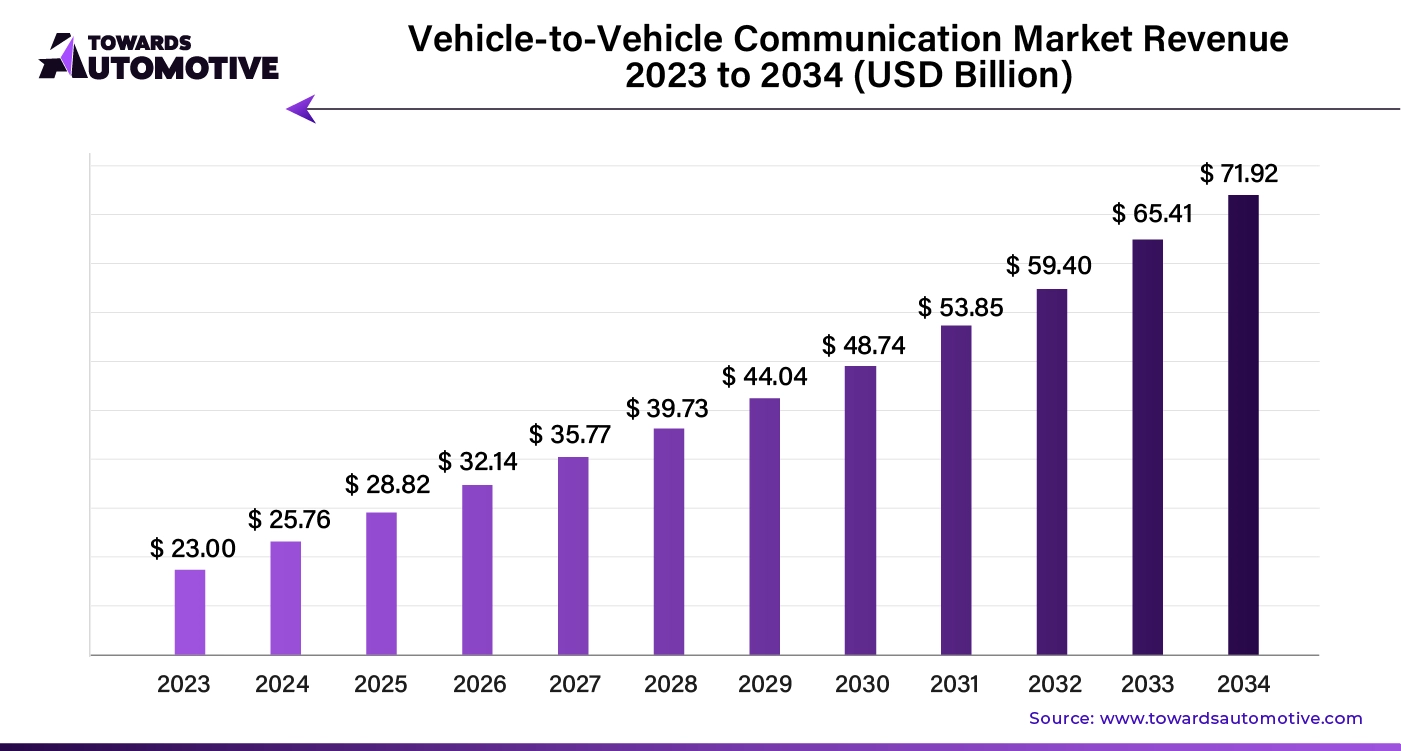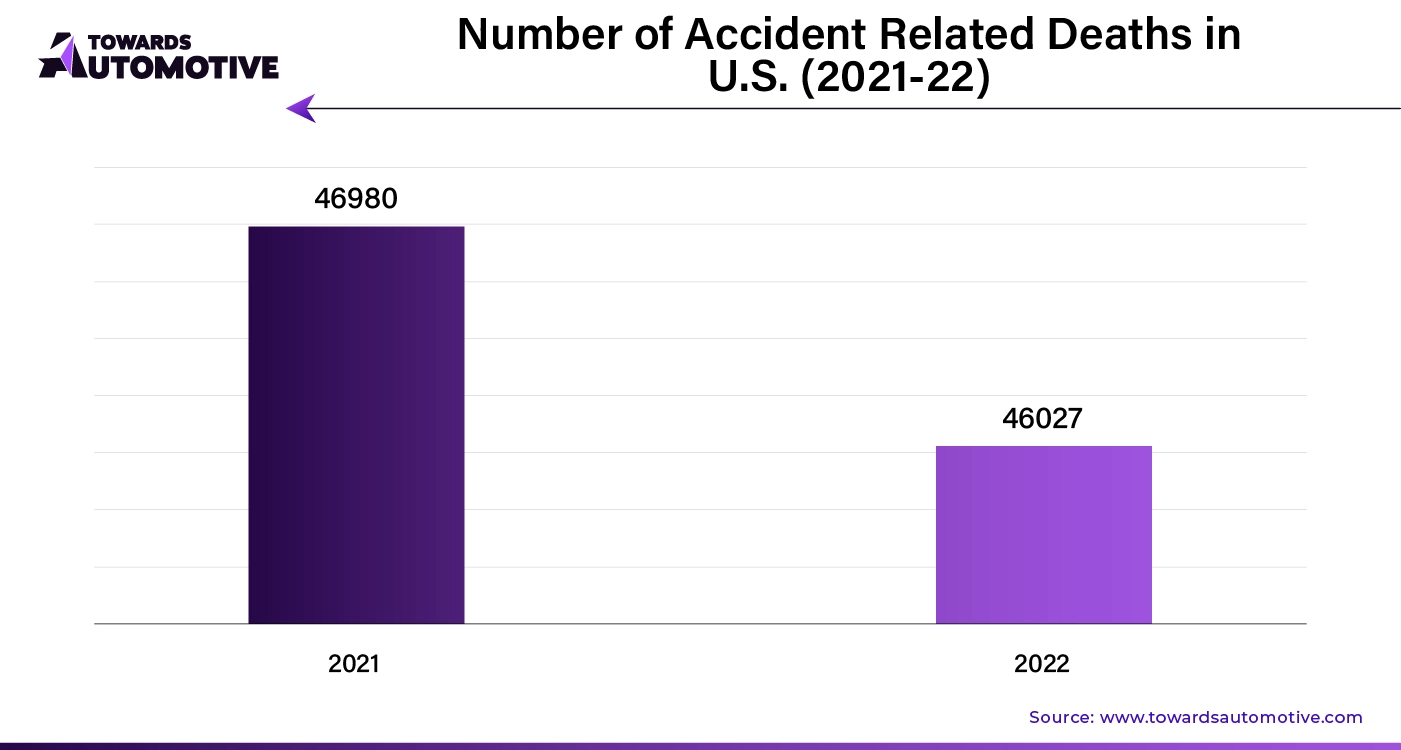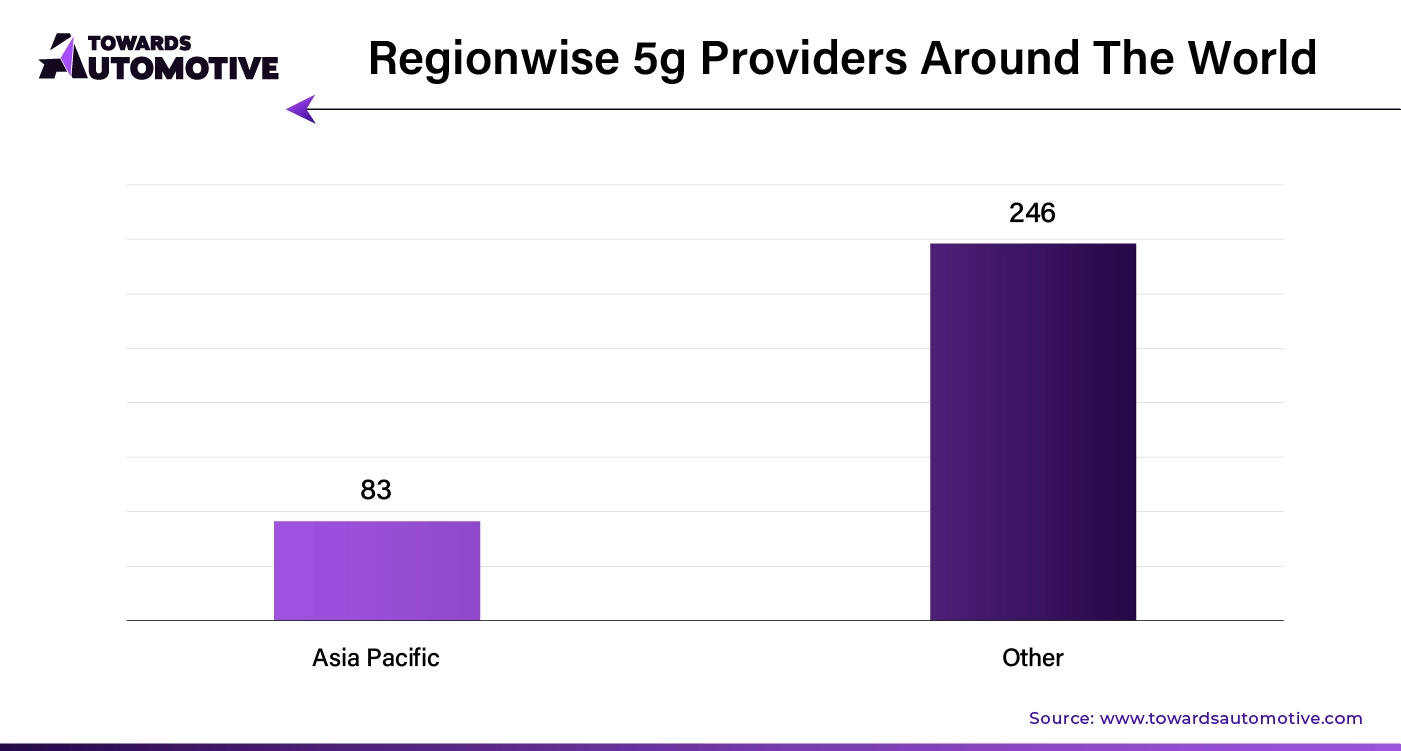March 2025

Senior Research Analyst

Reviewed By
The global vehicle-to-vehicle communication market size is calculated at USD 25.76 billion in 2024 and is expected to be worth USD 71.92 billion by 2034, expanding at a CAGR of 12.03% from 2024 to 2034.

The vehicle-to-vehicle communication market is experiencing rapid growth as the automotive industry moves toward more connected and autonomous vehicles. V2V communication technology allows vehicles to wirelessly exchange information about their speed, position, and direction with other nearby vehicles, creating a network of connected vehicles that can enhance road safety, reduce traffic congestion, and improve overall driving efficiency. This real-time communication enables vehicles to detect potential hazards, such as sudden braking or lane changes, and respond accordingly, minimizing the risk of collisions. As a result, V2V technology is increasingly being seen as a critical component in the push toward safer and more efficient roadways.
One of the primary drivers of the vehicle-to-vehicle communication market is government regulation and support. In many regions, regulatory bodies are advocating for the implementation of V2V technology as part of broader smart transportation initiatives aimed at improving traffic management and reducing accidents. For example, the National Highway Traffic Safety Administration (NHTSA) in the U.S. has been working toward mandating V2V communication in new vehicles to enhance safety on the roads. Similarly, countries in Europe and Asia are incorporating V2V technology into their smart city and intelligent transportation systems to address urban mobility challenges.
Technological advancements in wireless communication, such as the development of 5G networks, are also driving the growth of the V2V communication market. 5G offers low latency, high bandwidth, and reliable connectivity, which are essential for real-time data exchange between vehicles. The integration of 5G with V2V systems is expected to further enhance the capabilities of connected vehicles, enabling faster and more accurate communication between cars, improving safety features, and supporting the evolution of autonomous driving.
Additionally, the growing demand for advanced driver assistance systems (ADAS) and the development of fully autonomous vehicles are contributing to the expansion of the vehicle-to-vehicle communication market. As automakers invest heavily in the research and development of autonomous driving technologies, V2V communication is becoming a key enabler for achieving higher levels of automation, allowing vehicles to navigate complex traffic environments more efficiently. With its potential to revolutionize road safety and traffic management, the vehicle-to-vehicle communication market is poised for significant growth in the coming years
AI plays a pivotal role in the vehicle-to-vehicle communication market by enhancing the efficiency, reliability, and safety of connected vehicle networks. AI algorithms are used to process and analyze the massive amounts of data exchanged between vehicles in real-time, enabling faster decision-making and improving the overall functionality of V2V systems. Through machine learning, AI systems can predict potential hazards on the road, such as sudden braking, lane changes, or accidents, and communicate this information to other vehicles, allowing them to take preemptive actions like adjusting speed or steering to avoid collisions.
In addition to enhancing safety, AI helps optimize traffic flow by analyzing patterns and making adjustments to reduce congestion. For instance, AI-driven V2V systems can dynamically adjust traffic signals or recommend alternate routes to minimize traffic jams. This leads to more efficient travel times and reduced fuel consumption, benefiting both drivers and the environment.
AI also facilitates the integration of V2V communication with autonomous driving technologies. Autonomous vehicles rely on AI to interpret data from various sensors and V2V networks to make real-time decisions. As V2V communication evolves, AI will play a crucial role in enabling the seamless coordination of autonomous vehicles on the road, leading to safer and smarter transportation systems.
Rising cases of road accidents are a significant driver of growth in the Vehicle-to-Vehicle Communication Market. Road safety is a critical global concern, with millions of accidents occurring annually, leading to injuries, fatalities, and substantial economic losses. V2V communication technology offers a proactive solution to reduce the occurrence of accidents by enabling real-time communication between vehicles. Through V2V systems, vehicles can share data on speed, position, braking, and other critical parameters, allowing drivers to make informed decisions and avoid collisions.
One of the primary ways V2V communication enhances road safety is by providing early warnings about potential hazards. For example, if a vehicle ahead suddenly brakes or swerves, V2V systems can instantly relay this information to trailing vehicles, prompting them to take necessary actions such as reducing speed or changing lanes. This real-time alert system minimizes reaction times and significantly reduces the likelihood of rear-end collisions and pile-ups, especially in high-traffic or poor-visibility conditions.
Additionally, V2V communication is particularly beneficial in scenarios like intersection accidents, where vehicles may not be visible to one another due to obstructed views. By exchanging information about their locations and intended actions, vehicles can navigate intersections more safely, reducing the risk of side-impact collisions. This technology is also valuable in areas prone to harsh weather conditions, such as fog, rain, or snow, where visibility is reduced, and traditional driver-based navigation becomes challenging.
Governments and regulatory bodies are recognizing the potential of V2V technology to reduce accident rates and are pushing for its wider adoption. For instance, initiatives by organizations like the National Highway Traffic Safety Administration (NHTSA) in the U.S. aim to mandate V2V systems in all new vehicles, highlighting the growing emphasis on leveraging technology to improve road safety. Europe and Asia are also incorporating V2V communication as part of broader smart city and traffic management programs, further propelling market growth.
As road accidents continue to rise globally, the demand for advanced safety technologies like V2V communication is expected to increase. This surge in demand will drive innovation, regulatory support, and investments in V2V systems, positioning the market for substantial growth in the coming years.

The Vehicle-to-Vehicle Communication Market faces several key restraints, including high implementation costs and the lack of supporting infrastructure, especially in developing regions. The technology requires advanced hardware and reliable communication networks, both of which are expensive to deploy and maintain. Additionally, interoperability issues between different automakers' systems create challenges for seamless communication. Concerns over data privacy and cybersecurity further complicate widespread adoption, as drivers may hesitate to trust the constant exchange of sensitive vehicle data. Lastly, limited consumer awareness and acceptance of V2V technology pose barriers to its full integration into the automotive market.
The integration of 5G technology is set to revolutionize the Vehicle-to-Vehicle Communication Market, unlocking a range of new opportunities. With its ultra-low latency, high-speed data transfer, and massive connectivity, 5G will significantly enhance the efficiency and reliability of V2V systems. Vehicles will be able to exchange information almost instantaneously, improving the precision of real-time communication. This will enhance traffic safety, enabling faster responses to hazards and better coordination between vehicles, particularly in congested urban environments or high-speed situations.
Additionally, 5G’s ability to support high data throughput allows for more complex and richer data exchanges between vehicles, including high-definition maps, real-time video feeds, and advanced sensor data. This will empower vehicles to make better-informed decisions, further advancing the development of semi-autonomous and autonomous driving technologies. Furthermore, 5G’s network slicing capabilities will allow V2V systems to prioritize safety-critical information, ensuring that communication for collision avoidance or emergency braking gets immediate priority.
As automakers and governments push toward smart cities and intelligent transportation systems, the integration of 5G will be a key enabler of these advancements. It will provide the foundation for seamless communication between vehicles, infrastructure, and pedestrians, creating a safer and more efficient road environment.
The passenger car segment held the largest share of the market. The passenger car segment plays a pivotal role in driving the growth of the Vehicle-to-Vehicle Communication Market. As the global automotive industry increasingly adopts smart and connected technologies, V2V communication is becoming a key feature in passenger vehicles to enhance safety, reduce traffic congestion, and improve driving experiences. The rise in demand for advanced driver-assistance systems (ADAS) and semi-autonomous features is accelerating the adoption of V2V technology, as it allows vehicles to share real-time data on road conditions, traffic patterns, and potential hazards, helping to prevent accidents and improve road safety.
Passenger cars are at the forefront of the shift toward smarter mobility solutions, particularly as urbanization and population growth lead to greater vehicle density on roads. V2V communication enables cars to work together in a connected ecosystem, helping to optimize traffic flow and reduce emissions by minimizing stop-and-go driving. This is particularly important in congested urban areas, where real-time communication between vehicles can reduce bottlenecks and improve fuel efficiency.
Moreover, government regulations aimed at improving vehicle safety standards are driving automakers to incorporate V2V technology into their passenger car fleets. In regions like North America and Europe, where safety is a top priority, the installation of V2V communication systems is becoming a standard feature in new models. Automakers are also investing heavily in V2V technology to differentiate their vehicles in the competitive passenger car market, where consumers are increasingly seeking smarter, safer, and more connected driving experiences.
Europe dominated the vehicle-to-vehicle communication market. The growth of the Vehicle-to-Vehicle Communication Market in Europe is significantly driven by the rising adoption of Advanced Driver-Assistance Systems (ADAS) and autonomous vehicles, coupled with growing urbanization and traffic congestion, and the development of smart cities. As European automakers increasingly integrate ADAS into their vehicles, V2V communication becomes essential for enhancing these systems' effectiveness. V2V technology facilitates real-time data exchange between vehicles, which is crucial for improving safety and decision-making in advanced driving assistance and autonomous driving scenarios. This integration supports features such as collision avoidance, adaptive cruise control, and traffic signal timing adjustments, driving demand for V2V systems.
Simultaneously, Europe faces escalating urbanization and traffic congestion, particularly in major cities like London, Paris, and Berlin. The increasing density of vehicles on the road underscores the need for efficient traffic management solutions. V2V communication helps alleviate congestion by enabling vehicles to communicate directly, optimizing traffic flow, and reducing bottlenecks. This capability is vital for enhancing mobility in crowded urban environments.
Furthermore, the rise of smart cities across Europe is fostering an environment conducive to the expansion of V2V technology. Smart city initiatives focus on integrating various technologies to improve urban living, with V2V communication playing a key role in creating a connected transportation network. These initiatives often include investments in infrastructure and systems that support V2V communication, further boosting market growth. Together, these factors are propelling the adoption of V2V communication systems in Europe, making them a crucial component of the continent’s future transportation landscape.
Asia Pacific is expected to grow with a significant CAGR during the forecast period. The growth of the vehicle-to-vehicle communication market in Asia Pacific is being propelled by the rapid rollout of 5G technology, supportive government initiatives and regulations, and the expanding automotive industry. The deployment of 5G networks across the region is a game-changer for V2V communication, as it offers ultra-low latency, high-speed data transfer, and enhanced connectivity. These capabilities are crucial for the effective functioning of V2V systems, enabling vehicles to exchange information in real-time with minimal delay. The increased data throughput and reliability provided by 5G will facilitate more sophisticated communication, improving safety and traffic management.
Government initiatives and regulations in various Asia Pacific countries are also driving market growth. Governments in China, Japan, South Korea, and other nations are actively promoting the adoption of connected vehicle technologies, including V2V communication, to enhance road safety and support smart transportation systems. These initiatives often include subsidies, standards, and infrastructure investments that encourage the integration of V2V technology in new vehicles.
Moreover, the booming automotive industry in Asia Pacific is a significant driver of V2V communication adoption. The region is home to some of the world’s largest automotive manufacturers and a growing market for advanced vehicle technologies. As the demand for connected and autonomous vehicles rises, so does the need for V2V systems. Automakers are increasingly incorporating V2V technology into their vehicles to meet consumer expectations and regulatory requirements, further fueling the growth of the market. Together, these factors are creating a dynamic environment for the expansion of the V2V Communication Market in Asia Pacific.

By Connectivity Type
By Deployment Type
By Application
By End-Use
By Region
March 2025
March 2025
March 2025
March 2025
Dr. Arjun Patel is a distinguished expert in the automotive industry, holding advanced degrees in Automotive Engineering and Mechanical Engineering. His expertise spans automotive market dynamics, technological advancements, and sustainable practices. Dr. Patel excels in conducting in depth research and analysis on market trends, consumer preferences, and the economic implications within the automotive sector. He is renowned for his insightful publications on topics such as electric vehicles, autonomous driving technologies, and the evolution of sustainable transportation solutions. Dr. Patels research contributions have significantly advanced understanding in the field, earning him recognition as a leading authority in automotive research and analysis.
We offer automotive expertise for market projections and customizable research, adaptable to diverse strategic approaches.
Contact Us